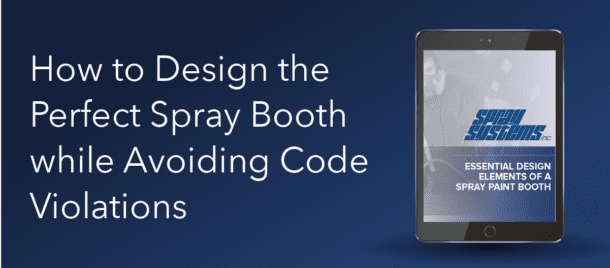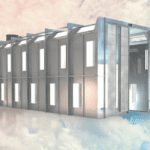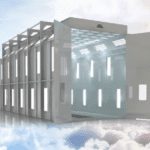Like any large engineering project, designing a spray paint booth requires certain assumptions to be made. Before ever having your booth designed, it’s important to first estimate the number of parts to be painted, the size of the booth, the number of colors to be used and more.
However, some assumptions about spray booth design are costly. These overlooked details can lead to last-minute design changes and increased costs. To help you avoid costly assumptions, we’ve outlined the most common assumptions and how they can impact the final spray paint booth design and functionality. The final product should integrate flawlessly into the production line if these assumptions are carefully examined by the manufacturer and booth designer.
Costly Assumption #1: Any Airflow Design Should Work
Airflow design goes beyond providing the proper quality of paint finish for each product. Maintenance costs increase if the proper airflow design is not taken into consideration.
Spray paint booth designers are required to meet certain OSHA and environmental regulations. One of these is airspeed, which is usually around 100 feet per minute. The fans that accelerate the air to the proper airspeed can be one of the most expensive pieces of equipment to run because they require high energy expenditures.
Additionally, the proper airflow design is matched to the paint overspray. If the overspray is not taken into account, the filters may need to be changed more often or at a non-optimal time.
The assumption that any airflow design is okay can lead to increased expenditures through:
- Higher utility costs from running the fans
- An inappropriate filter replacement timeline
Costly Assumption #2: There’s Already Enough Light for Sprayers
A well-lit factory seems like it should have appropriate lighting for paint sprayers to finish products. However, the light in the booth needs to be taken into consideration. Otherwise, the part’s finish quality can be affected.
OSHA regulations have specific requirements for the type of lighting that can be used. These regulations stipulate that only fixed lighting units may be used as a source of illumination through transparent panels, which means that portable lamps cannot provide a solution in this case. Therefore, it is critical to think through lighting during the design process.
The assumption that enough lighting should be available can be costly because:
- Underlit areas lead to low-quality finishes
- Adapting the booth for lighting after fabrication can lead to additional expenditures
Costly Assumption #3: Air Make-Up Systems Aren’t Necessary
A large, high-ceiling factory may seem like it has enough air to operate a spray paint booth. However, meeting the airflow and temperature requirements for the spray paint booth can be much more complex than that.
The air make-up unit is not an unnecessary add-on, but rather a critical component for regulating air temperature and pressure. A negative building pressure environment can cause improper airflow in some cases. Assuming that the air make-up system is not necessary can increase costs if it is determined that it may be needed later.
Costly Assumption #4: Booth Designers Will Worry About Building Requirements
Although spray paint booths may look like freestanding structures, they are integrated into your building. In many cases, installing a spray paint booth requires particular building permits. The designer must also comply with OSHA and fire safety requirements.
However, compliance doesn’t end with the design. Manufacturers must set processes in place to maintain compliance, such as cleaning sprinkler heads to allow proper fire suppression. Manufacturers and spray paint booth designers must work together closely to meet all the requirements.
Assuming that all of the fire safety, OSHA and building requirements will be met is risky. Violations can result in costly fees and even more expensive fixes. Manufacturers and spray paint booth designers need to communicate clearly to make sure that all the requirements are met.
Costly Assumption #5: Running Ducts Should be Easy!
Ducts are one area that’s often overlooked, however, they are central to maintaining correct airflows and minimizing duct static pressure. Improper duct design can also lead to increased fan sound levels and needs to be compliant with fire safety, OSHA and environmental regulations. While ducts are simple components, ignoring them can lead to increased costs due to redesigns late in the process.
Spray paint booths are complex construction projects. Overlooking the simpler details can lead to later cost increases. Adding components, such as an air make-up unit, at the end of the design process can be expensive. Lighting and ducting can become expensive components if they are not taken into consideration early in the process and a poor airflow design can lead to increased utility costs.
However, parts finishers and spray booth designers can work together to avoid these assumptions. Like any engineering project, taking care to examine all the angles and requirements is critical to success.
Contact our Spray Systems team to help you avoid costly assumptions when designing your spray booth.




